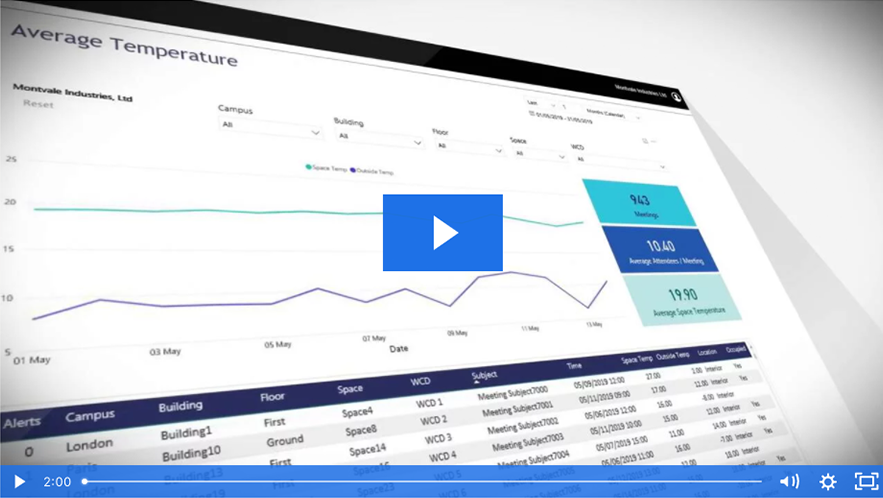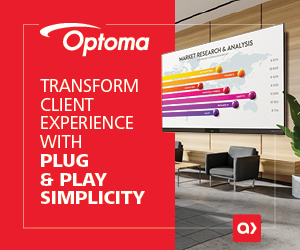Sharp thinks AV/IT integrators can offer data & analytics to improve meeting rooms using its Windows Collaboration Display and IoT sensors. Find out how.
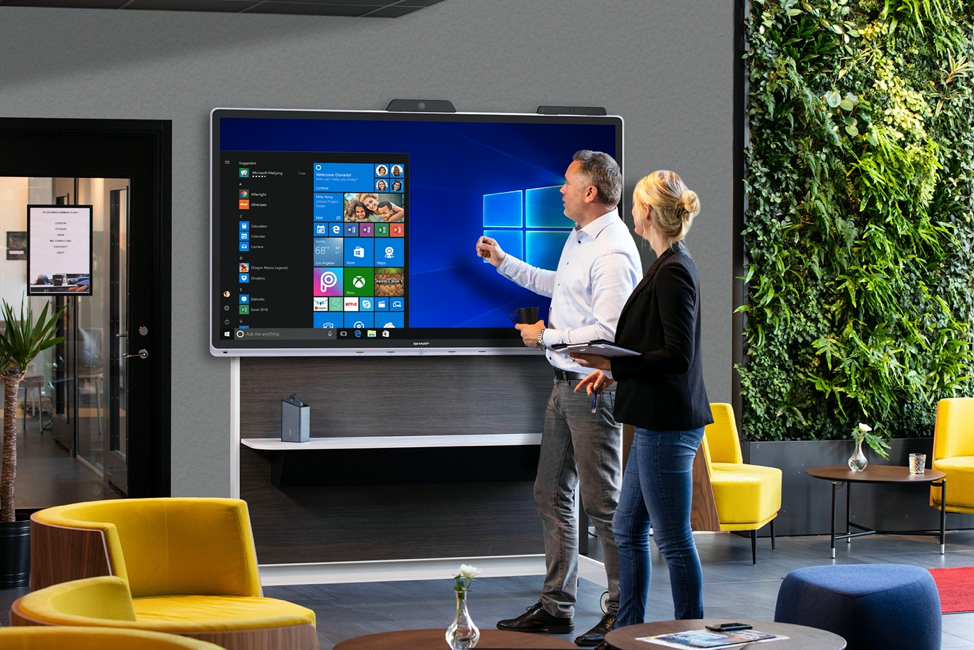
The impact of COVID-19 on the ProAV industry has gleaned mixed results: Rental and staging markets have been hard-hit, but collaboration and UCC verticals are booming. While continuing to support its partners in entertainment and live events, Almo Pro A/V has doubled down on supplying solutions in UCC — answering partners’ much-needed demand this year.
A collaboration solution delivering on this demand is the 70-inch Windows Collaboration Display (WCD) from Sharp. Almo is no stranger to the Sharp product line — the two have partnered for years. But Sharp’s WCD is a next big step for all of us in AV. Sharp’s not-so-secret sauce — an IoT sensor hub that provides data and analytics — is what sets this specific WCD apart from other WCDs and interactive flat panels.
The mindset of adding data and analytics is still fairly new in ProAV. To dig into this and learn more about the Sharp WCD, I talked to Mehryn Corrigan, associate director of alliance partner marketing at Sharp. The conversation winds from BYOD to IoT to AV-as-a-Service. And then some. Read on!
Note: This is the start of an interview between Almo’s Darren Altman and Sharp’s Mehryn Corrigan. It has been edited for grammar and clarity.
Darren Altman: Mehryn, it’s great to talk to you today. Like many, I’m excited about a collaboration product that’s gotten a lot of attention — the Sharp Windows Collaboration Display. I’ve heard about some of the features that make it such a forward-looking UCC solution. Aside from the 70-inch ideal size that’s gotten so much positive feedback, I’d love to hear more about how the product was designed: How does the Sharp Windows Collaboration Display handle and address the needs for multiple operating systems and collaboration platforms like Zoom and Microsoft Teams?
How does the Sharp WCD handle and address the needs for multiple operating systems and collaboration platforms?
Mehryn Corrigan: It made sense to create a collaboration device that was built on an open platform and could evolve with the changes. For instance, my own laptop has all different kinds of software on it. With the Sharp WCD, it’s so nice to be able to bring all the things I know and love (the programs and applications on my computer, for instance) with me. Through the BYOD (bring your own device) style of collaboration that the Windows Collaboration Display offers, my device can drive my meeting — instead of the other way around.
Darren Altman: I definitely agree that the office, no matter where your “office” is today, should cater to people’s preferences as far as what they use and how they want to connect. Speaking of connecting, and before we get into the big differentiator regarding the Sharp Windows Collaboration Display, the IoT sensor hub, tell me about the integrated hardware.
What hardware is included in the Sharp WCD?
Mehryn Corrigan: You’ve got it all in one product, so the complexity of pairing the best microphone with the best camera — that all goes away. It’s just one device. Sharp’s WCD includes not just the multi-touch screen but also the 4K camera and the audio system. Even the built-in microphone arrays are all integrated. There’s also your more traditional interactive flat panel feature — multi-touch ink — for digital annotation. And the display is certified as Crestron Connected. Ultimately, all this benefits the end user — and even those you wouldn’t initially consider, like facilities and building managers — in a great way. That’s in addition to benefiting the people in the actual room who just want things to work the way they expect them too.
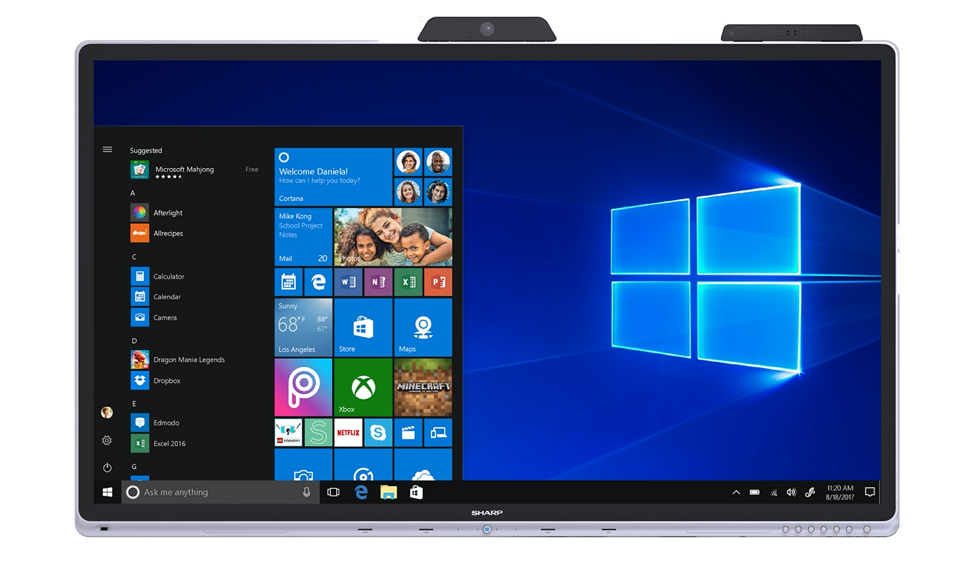
Darren Altman: We’ve all experienced that struggle with multiple devices. Back in the day, when I was traveling, I used to keep a work bag filled with tons of adapters, or all sorts of connectors, to, hopefully, make meetings go off without a hitch. I remember all the struggles with connectivity between laptop and display resulted in meetings just being delayed. How does the Windows Collaboration Display address these common connectivity issues and save us all valuable time?
How does the Sharp WCD address common connectivity issues?
Mehryn Corrigan: This is so relatable. But, you know, realistically, not everybody’s an AV guru like you and me. For the average user, it takes around 10 to 12 minutes* to start a meeting — that’s significant. There are a multitude of things that lead to this delay, and a lot of times it’s because you’re trying to connect to a meeting that’s hosted on a different platform than the one your room is built for. Sharp worked with Microsoft to make our version of the Windows Collaboration Display incredibly simple to connect for BYOD environments. We standardized it around a USB-C input. What’s so great about USB-C is that it has audio, video, power, touch. Previously, you had HDMI, the touch panel, power for the laptop — that’s three cables right there. Or you’re maybe running back to your desk to get your power cable because you forgot it. We also have HDMI and wireless connectivity built-in so you have multiple options.
Darren Altman: From a generational standpoint, there are five generations in the workplace right now. We know some people prefer wireless over wired. Others will take wired any day. How does the Sharp WCD touch on this?
Mehryn Corrigan: There’s no need to download anything. No drivers, no dongles. Connectivity is so simple: a right click on the corner of the PC and it automatically converts your audio and video to room scale on the device. In a room-based meeting space, you typically have to look for these settings (like audio and video) on your laptop to be able to sync them to the front-of-room display. With our WCD, that happens automatically. The whole premise of the Sharp WCD is to keep it simple.
Darren Altman: Right, like the laptop I’m working on has USB-C and DisplayPort — that’s just another connector for me to shove into my work bag. So there’s a ton of excitement around the Sharp Windows Collaboration Display, and one thing that’s quite unique and significant is the IoT sensor hub. What was Sharp’s thought-process behind adding it?
What was Sharp’s thought-process behind adding the IoT sensor hub?
Mehryn Corrigan: Microsoft has put a lot of emphasis into Azure — it’s a whole digital transformation with everything moving to the cloud. Microsoft Azure Digital Twins is an IoT platform where data from multiple IoT sensors is stored in a secure cloud database. Then the data can be analyzed, for example, by a smart building dashboard solution to help optimize the management of office space. This is significant in the AV world, and specifically for AV/IT integrators, where AV-over-IP is growing and systems are more connected. In the next year or two, the collaboration space will change dramatically.
Darren Altman: Can you give me an example of what that change looks like?
Mehryn Corrigan: Picture us all going back to the office; what we’ll start to see, if you’re not already seeing it, is a lot of meeting spaces converting — maybe your huddle spaces become one-person offices. Maybe your large conference rooms that used to seat eight now only seat two or three. At first, a lot of these meeting rooms were (or are) not equipped for video, so integrators are now getting that set up. But there’s another opportunity here — while you’re adding collaboration capabilities like interactive displays and videoconferencing devices, why not add IoT capabilities at the same time?
Darren Altman: What are the benefits of adding IoT — as opposed to just adding in an interactive flat panel or creating a Zoom Room?
For AV/IT specifically, what are the benefits of the IoT sensor?
Mehryn Corrigan: Adding IoT has three major touchpoints notable for the AV/IT manager.
- With IoT, you’re able to get data on how the spaces are being used — and with this data you can improve functions and processes in that room. This is an opportunity for the AV integrator to create a new revenue stream, one that’s recurring.
- Two, there’s the element of measuring productivity in the physical space — the IoT sensor hub measures specific elements, enabling integrators to connect their clients to powerful data that can improve the overall meeting experience. Take various elements of the physical room — at what temperature is the room set? What is the oxygen level in the room? Does air quality fluctuate throughout the day? And what about cooling down buildings when no one is even there? The sensor measures these elements to improve efficiency.
- The third touchpoint is around room utilization. How many times have we had to say there are not enough meeting spaces available? An IoT sensor hub gives integrators the tools to help customers optimize the space by measuring room occupancy and motion. For instance, that could mean measuring the amount of people who were in the room that day so we can provide proper cleaning and sanitation between meetings.
Darren Altman: Right. In short, connecting data to these spaces is an amazing way for the AV community to service them beyond just the initial install. In AV, we’re already managing the devices in the room, so why not make sure the room is optimized through data, as well?
Mehryn Corrigan: There is a lot of opportunity for integrators with the IoT element of the Sharp Windows Collaboration Display. We’re still at the very beginning stages of the technology, but the possibilities are exciting.
Darren Altman: So do you think IoT data can now be part of an AV organization’s managed services platform?
Could IoT data be part of an AV organization’s managed services platform? Does IoT as a category have the potential to really impact the AV industry?
Mehryn Corrigan: We’ve definitely started to see it — especially as we get further into the network where we’re managing uptime. AV integrators are already asked to design the conference rooms. I’m very hopeful that AV integrators will consider adding data and analytics on top of all the new conference-room integrations (like video) in the pipeline. I recently learned that around 80% of companies wished to have an IoT strategy but less than 50% actually have one. Everyone is already thinking about adding data, but we’re not really sure how to manage it yet. The Sharp WCD opens the door to get AV and IT started.
Darren Altman: Doesn’t it also grow with you over time? Regarding the evolution of the sensor hub and updates over the air?
Mehryn Corrigan: Yes, take the AI camera that’s built in. Over time, with more developments in the Azure platform and cloud firmware updates, you can enable more feature sets that help the device measure room analytics. The Sharp WCD is a simple door opener with the possibility of much more long-term.
Takeaway: AV/IT Should Invest in the Sharp WCD — Here’s Why
My interview with Mehryn shed light on a lot of great features of the Sharp Windows Collaboration Display that I hadn’t considered. It also reminded me how important it is to specify a product that grows with you over time and doesn’t force end users to use it one way or the other.
For instance, along with being Skype-for-Business-certified, Sharp’s WCD comes as a Microsoft Office 365–ready product. What’s great, though, is you’re not just limited to Microsoft; via USB-C, a connector used with both the latest Windows and Apple Mac products, the Sharp WCD allows you to operate in any “world.” In other words, you’re not limited to one operating system even though it comes Windows-ready. All you have to do is connect your own device and the display’s cameras, microphones and speakers automatically appear on the front-of-room device. The benefit? Users can get the same collaboration experience on the room device as they would on their own devices.
After talking to Mehryn, here’s what I realized makes this product different: Times have changed, and collaboration boards are no longer just interactive displays with a nice touch interface. End users are demanding all-in-one collaboration solutions that can literally “read the room,” providing data to the customers. AV integrators are finding that they are the ideal people to help customers attain this data through the collaboration technology itself.
Notably, this is something integrators have been catching onto as the news makes the rounds. If given the capability to manage that data (to keep servicing the Sharp WCD product as it grows over time), integrators could have a brand new managed-services offering on their hands. In our minds, AV/IT postures should definitely be straightening at the idea of this, because this isn’t just an idea or dream anymore; it’s actually a reality.
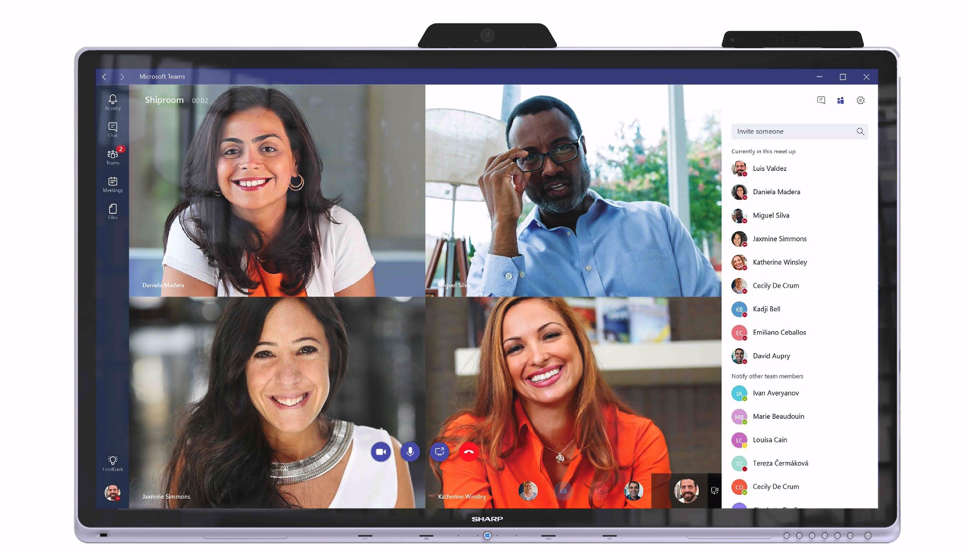
On Aug. 26, Commercial Integrator held a great webinar, “How Analytics are Driving Digital Transformation in Today’s Modern Office,” featuring Almo and Sharp. It was a great follow-up to the discussion we had here. Register and view the webinar here.
Learn more at AlmoProAV.com/Sharp, and get in touch with Darren Altman, Almo business development manager, for more information on the Sharp Windows Collaboration Display.

